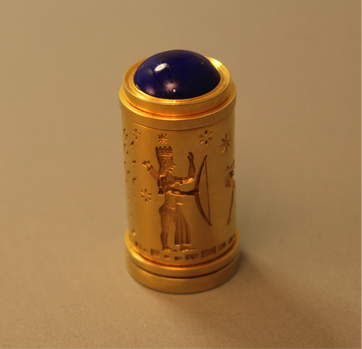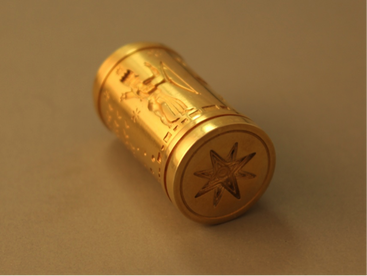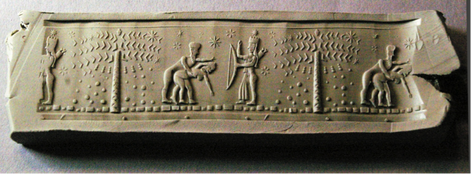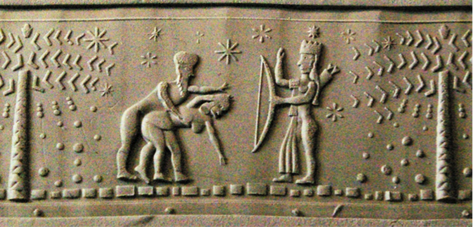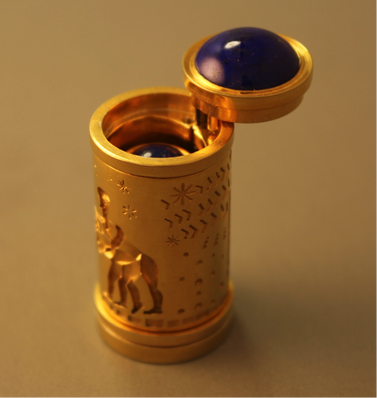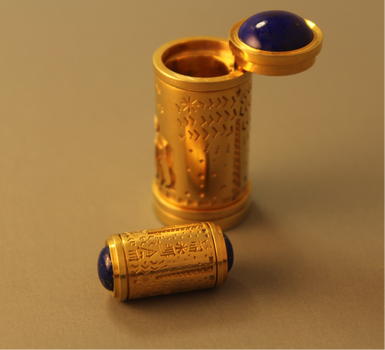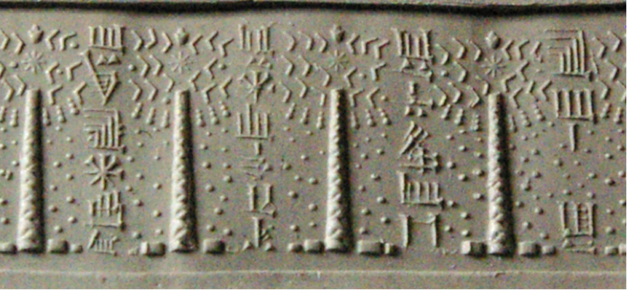BABYLONIAN CYLINDER SEAL
From Ancient Babylon, a Discovery of Great Importance
Kent P. Streaver, Ph.D., FNAS, GAA, DMv
And there were voices, and thunders, and lightnings; and there was a great earthquake, such as was not since men were upon the earth, so mighty an earthquake, and so great. On Babylon, from the King James Bible, Revelation 16:18
The story of this discovery begins the summer of 2002, at a cafe with friends and admirers after I gave a well received lecture at a local university. I was thinking out loud about interesting parallels that could be drawn between ancient Babylon and modern Iraq , and a gentlemen next to me encouraged me to pursue such a project. When I mentioned that I had colleagues in Iraq who could be counted on for logistical support, his encouragement became enthusiastic, and we spent the rest of the evening discussing the creation of such an expedition. He was especially interested in my ability to travel inconspicuously in areas typically not visited by tourists or scholars. It was a fortuitous meeting – I had the expertise and ability, and he was searching for deserving projects to fund through the organization he represented, the Habillurton Foundation. The Foundation was anxious to start our project, and with their generous support I was able to organize my expedition in record time, arriving in Baghdad that winter.
I immediately got in touch with a colleague who could not only navigate the difficult paths of government support for my work in Iraq, but also verify the age of any artifacts I would discover. I engaged the services of Dr. Jemyel Sedyeqh, from the local Carbon Dating Service, and we spent that first evening discussing the goals of my expedition. When I mentioned my interest in visiting sites not usually visited, Dr. Sedyeqh thought for a moment, then said: “Stree, I have just the place!” (She had the endearing habit of giving her best clients nicknames that were a shortening of their full name. Or perhaps she had difficulty pronouncing my full name – this is an excellent example of how my travels lead to interesting sociological observations.) Dr. Sedyeqh was extremely skilled and knowledgeable, with connections in the highest places. She related that one of her steady clients was quite a high ranking official who owned a large private collection of artifacts from Mesopotamia which had never been made available to the academic community. She was intimately familiar with the collection, and was so captivated by my project that she offered to give me a private tour as a starting point for our work. Checking her schedule, she advised me that she could bring me there in two days hence. We spent the next two days developing our working relationship and exploring how we could best optimize the available time and resources I had for this expedition.
The day of my tour arrived, and Dr. Sedyeqh informed me that we would be going to the collection in the late evening for an undisturbed viewing. That night, our car brought us to the rear of a large, palatial structure overlooking the Euphrates River, and Dr.Sedyeqh led me to an inconspicuous door in an alley. Producing a key, she opened the door and we entered. Guiding me through a maze of deserted hallways, she stopped before a large, ornately decorated door, produced another key, and we entered the room housing the collection. It was an interesting gallery, set up in the format of a grand bedroom in the style of ancient Babylon. Along one wall were the groupings of artifacts we had come to see. Dr. Sedyeqh told me that she would meet there on a regular basis with her client to discuss how the artifacts represented actual activities of life in ancient times, and the similarities and differences between ancient and modern techniques. She went on to relate that often it is helpful to act out scenes depicted for better understanding of life in ancient times. Offering to show me her client’s favorite piece, Dr. Sedyeqh removed a small object from a case and handing it to me, explaining that it was from the realm of Nebuchadnezzar II, around 600 B.C.E.. At that moment, we heard the sound of a distant door opening, and I saw a look of panic on Dr. Sedyeqh’s face.
She said, in a low and urgent tone, “Hu is at the door!”
I replied, “I don’t know, who is at the door?”
Dr Sedyeqh: “Yes – it is Sad!”
I did not understand what was so unhappy about the situation, but perhaps Dr Sedyech had forgotten to make all of the proper notifications for our visit. Cautiously inspecting the hall outside, she quickly brought me back the way we came, out to the car, and back to my quarters.
When we arrived in my rooms, I realized that I still held the object that Dr. Sedyeqh had given me in the gallery, and I asked her to tell me about it. The panicked look that had almost left her face was replaced by one of abject terror. She told me that our accidental removal of the piece would be considered theft and an act of espionage, and that her known possession of the keys would implicate her. She advised me that she was leaving town immediately, and that I should do the same if I valued my life. As she was rushing out the door, I stopped her to ask what was so important about the object, which I saw to be a decorative cylinder seal. Her rushed and unguarded response was that she thought her client simply liked discussing the scene depicted more than other similar seals in the collection. Then a memory came to her about something her client had mentioned in passing - that this seal was the reason that excavation and rebuilding of the ancient ruins of the Summer Palace had been started a number of years ago. With those last words, she was gone.
Not wishing to cause any more trouble for Dr. Sedyeqh, I left Baghdad on the next flight out, without incident, retaining the cylinder seal to guard it against any mishap until I was able to return it safely to the gallery where it rightly belonged.
The story of this discovery begins the summer of 2002, at a cafe with friends and admirers after I gave a well received lecture at a local university. I was thinking out loud about interesting parallels that could be drawn between ancient Babylon and modern Iraq , and a gentlemen next to me encouraged me to pursue such a project. When I mentioned that I had colleagues in Iraq who could be counted on for logistical support, his encouragement became enthusiastic, and we spent the rest of the evening discussing the creation of such an expedition. He was especially interested in my ability to travel inconspicuously in areas typically not visited by tourists or scholars. It was a fortuitous meeting – I had the expertise and ability, and he was searching for deserving projects to fund through the organization he represented, the Habillurton Foundation. The Foundation was anxious to start our project, and with their generous support I was able to organize my expedition in record time, arriving in Baghdad that winter.
I immediately got in touch with a colleague who could not only navigate the difficult paths of government support for my work in Iraq, but also verify the age of any artifacts I would discover. I engaged the services of Dr. Jemyel Sedyeqh, from the local Carbon Dating Service, and we spent that first evening discussing the goals of my expedition. When I mentioned my interest in visiting sites not usually visited, Dr. Sedyeqh thought for a moment, then said: “Stree, I have just the place!” (She had the endearing habit of giving her best clients nicknames that were a shortening of their full name. Or perhaps she had difficulty pronouncing my full name – this is an excellent example of how my travels lead to interesting sociological observations.) Dr. Sedyeqh was extremely skilled and knowledgeable, with connections in the highest places. She related that one of her steady clients was quite a high ranking official who owned a large private collection of artifacts from Mesopotamia which had never been made available to the academic community. She was intimately familiar with the collection, and was so captivated by my project that she offered to give me a private tour as a starting point for our work. Checking her schedule, she advised me that she could bring me there in two days hence. We spent the next two days developing our working relationship and exploring how we could best optimize the available time and resources I had for this expedition.
The day of my tour arrived, and Dr. Sedyeqh informed me that we would be going to the collection in the late evening for an undisturbed viewing. That night, our car brought us to the rear of a large, palatial structure overlooking the Euphrates River, and Dr.Sedyeqh led me to an inconspicuous door in an alley. Producing a key, she opened the door and we entered. Guiding me through a maze of deserted hallways, she stopped before a large, ornately decorated door, produced another key, and we entered the room housing the collection. It was an interesting gallery, set up in the format of a grand bedroom in the style of ancient Babylon. Along one wall were the groupings of artifacts we had come to see. Dr. Sedyeqh told me that she would meet there on a regular basis with her client to discuss how the artifacts represented actual activities of life in ancient times, and the similarities and differences between ancient and modern techniques. She went on to relate that often it is helpful to act out scenes depicted for better understanding of life in ancient times. Offering to show me her client’s favorite piece, Dr. Sedyeqh removed a small object from a case and handing it to me, explaining that it was from the realm of Nebuchadnezzar II, around 600 B.C.E.. At that moment, we heard the sound of a distant door opening, and I saw a look of panic on Dr. Sedyeqh’s face.
She said, in a low and urgent tone, “Hu is at the door!”
I replied, “I don’t know, who is at the door?”
Dr Sedyeqh: “Yes – it is Sad!”
I did not understand what was so unhappy about the situation, but perhaps Dr Sedyech had forgotten to make all of the proper notifications for our visit. Cautiously inspecting the hall outside, she quickly brought me back the way we came, out to the car, and back to my quarters.
When we arrived in my rooms, I realized that I still held the object that Dr. Sedyeqh had given me in the gallery, and I asked her to tell me about it. The panicked look that had almost left her face was replaced by one of abject terror. She told me that our accidental removal of the piece would be considered theft and an act of espionage, and that her known possession of the keys would implicate her. She advised me that she was leaving town immediately, and that I should do the same if I valued my life. As she was rushing out the door, I stopped her to ask what was so important about the object, which I saw to be a decorative cylinder seal. Her rushed and unguarded response was that she thought her client simply liked discussing the scene depicted more than other similar seals in the collection. Then a memory came to her about something her client had mentioned in passing - that this seal was the reason that excavation and rebuilding of the ancient ruins of the Summer Palace had been started a number of years ago. With those last words, she was gone.
Not wishing to cause any more trouble for Dr. Sedyeqh, I left Baghdad on the next flight out, without incident, retaining the cylinder seal to guard it against any mishap until I was able to return it safely to the gallery where it rightly belonged.
The Cylinder Seal
Arriving back in my studios in New York, I immediately began a study of the cylinder seal. The intaglio was carved into a cylinder of gold, capped on one end by polished lapis lazuli (Fig. 1), and on the other by a flat seal carved in gold with the symbol of Ishtar, an eight pointed star (Fig. 2).
Arriving back in my studios in New York, I immediately began a study of the cylinder seal. The intaglio was carved into a cylinder of gold, capped on one end by polished lapis lazuli (Fig. 1), and on the other by a flat seal carved in gold with the symbol of Ishtar, an eight pointed star (Fig. 2).
The scene depicts Ishtar, goddess of both love and war, with the weapons of war held in a peaceful attitude (bow reversed) and with her garments opened to expose her body. This is the goddess of love. A priest and priestess are bowing before their goddess. A tree bearing fruit serves as backdrop to this peaceful scene of Ishtar and her worshippers (Fig. 3).
Thinking back to Dr. Sedyeqh’s last comments about the seal, and her thought that it had something to do with the restoration of the Babylonian Summer Palace, I was puzzled – what did Ishtar and her priests have to do with the Summer Palace? Carefully examining the end caps, I determined to remove one to see if perhaps there was a clue inside. Neither cap could easily be pried away from the cylinder, I tried twisting the lapis lazuli end cap in an effort to free its attachment to the cylinder, to no avail. I tried the other side, and felt the slightest movement. After carefully cleaning around the seam, I tried again to rotate the end cap. After initial resistance, to my astonishment the slight rotation of the flat seal actuated an ancient spring mechanism that allowed the lapis lazuli cap to move up and rotate aside to reveal a compartment within the seal (Fig. 4).
I peered into the opening to see an object within. I carefully removed what was revealed to be another carved gold cylinder seal, capped at both ends with stone (Fig. 5).
It was obviously carved by the same artisan that carved the outer seal, as it depicted a grove of the same fruitful trees. These trees were not backdrop to another religious scene, but to carefully incised cuneiform text (Fig. 6). I felt important secrets were about to be revealed. Fortunately, I am fluent in cuneiform, and immediately started the process of translating the text.
With mounting excited, as the meaning of the cuneiform became clear, I understood the connection to the Summer Palace! These were directions! The text reads:
sha DINGIR.AG-NIG2.DU-URU3 /
LUGAL KA2.DINGIR.RA /
E2.GAL BURU14 /
sha-pal IM.SHU.RIN
And it’s meaning is:
Of Nebuchadnezzar /
King of Babylon /
Palace of Summer /
beneath the furnace
What was hidden beneath the furnace in the Summer Palace? There was no indication within the images of the seal. But, the first seal concealed a secret inside, why not this one! Hands shaking with excitement, I carefully attempted to remove one of the stone endcaps, and with some resistance the cap gave up its hold on the secret of the seal. Inside was yet another, smaller gold cylinder seal, capped in what appeared to be ebony and gold (Fig. 7) .
sha DINGIR.AG-NIG2.DU-URU3 /
LUGAL KA2.DINGIR.RA /
E2.GAL BURU14 /
sha-pal IM.SHU.RIN
And it’s meaning is:
Of Nebuchadnezzar /
King of Babylon /
Palace of Summer /
beneath the furnace
What was hidden beneath the furnace in the Summer Palace? There was no indication within the images of the seal. But, the first seal concealed a secret inside, why not this one! Hands shaking with excitement, I carefully attempted to remove one of the stone endcaps, and with some resistance the cap gave up its hold on the secret of the seal. Inside was yet another, smaller gold cylinder seal, capped in what appeared to be ebony and gold (Fig. 7) .
The image of this seal revealed the secret that had led to the renovation and search of the summer palace, a secret of old methods of destruction that when out of control could be used to destroy not just the single city of Babylon, but entire nations.
The images on this smallest seal depict a powerful scene:
King Nebuchadnezzar II, releasing a large constructed form.
A cloud of dust, sending weapons of warfare in all directions accompanied by the eight pointed stars of Ishtar, goddess of war.
The same tree, by the same artisan, that appeared on the other seals, but this tree bore no fruit – instead it was dropping its dead leaves as it died (Fig. 8).
The images on this smallest seal depict a powerful scene:
King Nebuchadnezzar II, releasing a large constructed form.
A cloud of dust, sending weapons of warfare in all directions accompanied by the eight pointed stars of Ishtar, goddess of war.
The same tree, by the same artisan, that appeared on the other seals, but this tree bore no fruit – instead it was dropping its dead leaves as it died (Fig. 8).
I understood. The implications of what I was seeing were far reaching, and I knew what I had to do. On this dreary day in March of 2003 I called my sponsor at the Foundation, explained what I had discovered, and asked if he had any way to bring this information to responsible powers in government. The rest is history. The world is now a safer place, thanks to a government that could respond quickly and surely when presented evidence of a terrible threat, and thanks to the Science of Archaeology.
Notes to the text
[1] The Habillurton Foundation was established to explore the technology, socio-economics, and history of countries in conflict, and how those countries impact the rest of humanity. Its representatives fearlessly travel the world in their search for truth, justice, and the American way.
[2] Carbon dating utilizes the principle of exponential decay of radiocarbon isotopes to determine the age of an object.
[3] Nebuchadnezzar II, c 634 – 562 BCE, freed Babylon from Assyria and expanded his kingdom, and created such technological wonders as the Hanging Gardens of Babylon and the Ishtar gate
[4] In her book “Near Eastern Seals”, University of California Press, Dominique Collon explains that seals were used to authenticate early administrative documents of many types either by stamping a simple seal or rolling a cylinder seal across an area of soft clay, and cylinder seals “were more suited for sealing large areas on tablets or their clay envelopes, and on the large clay sealings of jars, containers, and doors….In some areas, a compromise seal was developed which was cylinder shaped but also had a design carved on its base so that it could be used as a stamp seal.”
[5] Lewis, Paul, “Babylon Journal; Ancient King’s Instructions to Iraq: Fix My Palace”, New York Times, April 19, 1989 In this article, Mr. Lewis describes how “President Saddam Hussein, Iraq's strong-armed ruler, is sparing no effort to obey that distant command” of King Nebuchadnezzar to ”repair and rebuild his temples and palaces.”
[6] In his book “Cylinder Seals of Western Asia,” Batchworth Press, D.J.Wiseman explains that although most cylinder seals of the period were made of stone, “metal was in use in Ancient Iraq throughout the period in which these seals were made.”
[7] With thanks for the assistance of Gary Beckman, Professor of Hittite and Mesopotamian Studies, University of Michigan.
[8] DAVID E. SANGER with JOHN F. BURNS, “The White House: Bush Orders Start of War on Iraq”, New York Times, March 20, 2003 In this article, Mr. Sanger writes: “ It appeared that the war started earlier than the White House and top Pentagon officials had intended… Mr. Bush decided to act on fresh intelligence…”
[1] The Habillurton Foundation was established to explore the technology, socio-economics, and history of countries in conflict, and how those countries impact the rest of humanity. Its representatives fearlessly travel the world in their search for truth, justice, and the American way.
[2] Carbon dating utilizes the principle of exponential decay of radiocarbon isotopes to determine the age of an object.
[3] Nebuchadnezzar II, c 634 – 562 BCE, freed Babylon from Assyria and expanded his kingdom, and created such technological wonders as the Hanging Gardens of Babylon and the Ishtar gate
[4] In her book “Near Eastern Seals”, University of California Press, Dominique Collon explains that seals were used to authenticate early administrative documents of many types either by stamping a simple seal or rolling a cylinder seal across an area of soft clay, and cylinder seals “were more suited for sealing large areas on tablets or their clay envelopes, and on the large clay sealings of jars, containers, and doors….In some areas, a compromise seal was developed which was cylinder shaped but also had a design carved on its base so that it could be used as a stamp seal.”
[5] Lewis, Paul, “Babylon Journal; Ancient King’s Instructions to Iraq: Fix My Palace”, New York Times, April 19, 1989 In this article, Mr. Lewis describes how “President Saddam Hussein, Iraq's strong-armed ruler, is sparing no effort to obey that distant command” of King Nebuchadnezzar to ”repair and rebuild his temples and palaces.”
[6] In his book “Cylinder Seals of Western Asia,” Batchworth Press, D.J.Wiseman explains that although most cylinder seals of the period were made of stone, “metal was in use in Ancient Iraq throughout the period in which these seals were made.”
[7] With thanks for the assistance of Gary Beckman, Professor of Hittite and Mesopotamian Studies, University of Michigan.
[8] DAVID E. SANGER with JOHN F. BURNS, “The White House: Bush Orders Start of War on Iraq”, New York Times, March 20, 2003 In this article, Mr. Sanger writes: “ It appeared that the war started earlier than the White House and top Pentagon officials had intended… Mr. Bush decided to act on fresh intelligence…”
